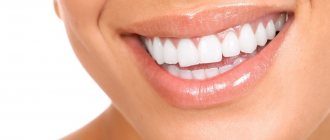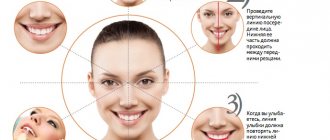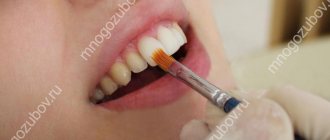March 20 is the International Day of Happiness, proclaimed in 2012. The presence (or absence) of a smile on the face is one of the key indicators of how happy a person feels. It is difficult to sincerely enjoy life with a gloomy face.
At the same time, the ability to smile beautifully not only helps you look better in photographs, but also changes the tone of your speech. Radio DJs know this - they always smile when speaking into the microphone. At the same time, learning to smile is not so difficult - the main thing is to regularly practice this habit.
Watch your lips
It's no secret that when you smile, it is your lips that attract the most attention. Therefore, it is very important that they are not chapped or bitten. Be sure to use lip moisturizers, and in winter regularly smear with balms or hygienic lipstick.
Don't forget to pay attention to your lip makeup. Try not to use too bright lipstick, especially if you have thin lips - otherwise they will visually become even thinner. It is better to choose products in natural colors, with shine. Products with menthol help to slightly enlarge lips and make them plumper and seductive.
Neglect of hygiene
It would seem that brushing your teeth is a daily routine that you can’t skip.
But during the pandemic, many have lost the habit of this. If there is no reason to leave the house, then there is no reason to take care of your oral cavity. This position is dangerous to health: without daily cleaning, bacteria multiply faster. Sensitivity of the gums and teeth can lead to problems throughout the body - diseases of the gastrointestinal tract, heart or lungs. Now that our body is already vulnerable, it is important to help it cope with environmental hazards. Daily dental care is one of the main weapons in the fight against bacteria and viruses.
If you notice any of these problems, make an appointment with your dentist to get your healthy smile back as soon as possible!
Gymnastics for lips
You may know how to smile correctly, but your muscles just can't create the right smile. Fortunately, they can be trained with simple exercises. All of them need to be done 3-5 times:
- Stick your tongue out as far as possible, hold for 3 seconds and return back;
- Exhale sharply, as if you were blowing out a candle;
- Exhale slowly through pursed lips. After exhaling, relax your facial muscles and smile as wide as possible;
- Open your mouth a little and start chewing, like camels chew. Try to move your cheekbones as far as possible. You can try making a figure eight with your lower jaw;
- Sing the sounds A-I-O-U loudly, one at a time, in one breath. Then inhale again, puff out your cheeks and exhale, creating a slight vibration of your lips;
- Exhale slowly through your pursed lips, as if creating pressure;
- Stretch your lips forward as much as possible, fold them into a tube and open and close them like a fish;
- For three minutes, try to whistle any melody as loudly and clearly as possible.
Mastering the exercises
What to do if an ugly smile interferes with communication with other people? Mastering special techniques that teach you how to control facial expressions will help. What exercises should you practice for the most beautiful smile?
- Bring your index finger to your lips at a distance of 2 cm. Reach towards it with your lips folded together as a “kiss”. Open and then close your mouth, relax your muscles.
- Extend your closed lips and “draw” an infinity sign in the air.
- Stretch your mouth into the widest smile and hold for 10-15 seconds. Then let the muscles relax.
- Extend your tongue forward and try to “hug” the organ with your lips. Hold the position for 10 seconds.
- Take as deep a breath as possible and try to exhale through tightly clenched lips.
Each exercise is repeated daily at least 15-20 times. After a couple of weeks of training, the first result will be noticeable. Simple exercises will not only help you hone your smile skills, but are also an excellent preventative against the appearance of early facial wrinkles.
Pay attention to your teeth
How to smile beautifully with teeth? The answer to this question lies primarily in the beauty of teeth. Your smile will be charming only if your teeth are even and snow-white. So treat all cavities and visit your dentist for a professional cleaning - once the plaque and tartar are removed, your teeth will definitely become whiter. And if this is not enough, then you can also whiten your teeth, for example, with a laser - this way they will definitely become significantly whiter.
If you want to become the owner of a truly snow-white smile, then you should definitely think about veneers - thin ceramic plates that completely cover the front teeth and hide all their defects. Many celebrity smiles are the result of using veneers or their thinner analogues - lumineers.
Seven main violations when creating a smile design
Students and practitioners are increasingly turning to digital smile design techniques to directly demonstrate potential aesthetic changes to patients and healthcare team members (including dental technicians). The principles of smile design include studies of facial aesthetics, labiodental dynamics, gum and dentition architecture, as well as the phonetic component. To better explain to patients and demonstrate to their colleagues the dynamics of aesthetic changes in the smile, many doctors do a fantastic job of illustrating the principles of smile design in relation to the ideal state of harmony required, based on the individual anatomical features and physiological characteristics of each individual patient.
This approach is useful not only from a demonstration point of view, but also in terms of identifying possible violations that compromise the aesthetic appearance. Therefore, recommendations regarding the proper assessment and resolution of specific errors encountered during the smile design stage provide some guidance in the practice of aesthetic dentistry.
This article discusses seven main violations in the formation of design, as well as methods for assessing them and solving them to restore the ideal harmonious form.
1. Crooked smile
A crooked smile is an extremely noticeable violation not only for a dentist, but also for an ordinary person, like a crooked shelf on a flat wall. After restoration, few people additionally check the condition of the interincisal line, but it is this line that affects the visual inclination of the smile line relative to the vertical axis (photo 1 and photo 2). Straightening your smile requires developing a preliminary treatment plan that takes into account basic aesthetic principles. Among the aspects that definitely need to be examined: horizontal and vertical parameters of the face, including the line connecting the corners of the mouth, as well as the interpupillary horizontal line. A vertical line drawn through the middle of the face should be assessed in relation to the bridge of the nose, the tip of the nose and the middle of the chin. It is also important to ensure that the interincisal contact line is perpendicular to the absolute horizontal. To prevent a crooked smile, it is important to understand that the analysis of facial aesthetics should begin with studying the patient’s photograph, and in no case should it be reduced to the analysis of models (which is an extremely popular violation, taking into account the fact that even models in the majority are analyzed only on the subject of interest area of the jaw). When studying the planes of the face, it is necessary to take into account the patient’s characteristic horizontal position of the head, since it is largely the starting point for the further formation of the smile design. As a rule, this criterion in most cases coincides with the absolute horizontal plane, relative to which some facial features may have disturbances (as a consequence of the asymmetry effect). It is also important to analyze the facial area as a whole, and not concentrate on the position of only the area of interest relative to the horizontal plane. Restoring the horizontal plane is also an important aspect of collaboration with the dental technician using a facebow and wax-up (Photo 3 and Photo 4).
Photo 1. A comprehensive facial analysis before intervention is the key to treatment success. Changes in the interincisal angle, which may not be noticeable, can be detected through graphical analysis of photographs, which also facilitates collaboration with the laboratory when correcting a crooked smile (restorations made by IPS e.max and IPS Empress (Ivoclar Vivadent)
Photo 2. A comprehensive facial analysis before intervention is the key to treatment success. Changes in the interincisal angle, which may not be noticeable, can be detected through graphical analysis of photographs, which also facilitates collaboration with the laboratory when correcting a crooked smile (restorations made by IPS e.max and IPS Empress (Ivoclar Vivadent)
Photo 3. The use of a facebow and mock-up helps the dentist coordinate the dental technician regarding the required position of the incisal edges and interincisal line, which makes the final treatment results more predictable.
Photo 4. The use of a facebow and mock-up helps the dentist coordinate the dental technician regarding the required position of the incisal edges and interincisal line, which makes the final treatment results more predictable.
2. Reverse smile
Formation of a smile requires maintaining symmetry between the cutting edge of the anterior teeth of the upper jaw and the border of the lower lip following it (the principle of labiodental dynamics). Labiodental dynamics are formed from the cutting edge, where a convex line is created that extends into the area of the chewing teeth. The chewing teeth, as a rule, follow the level of the occlusal plane parallel to the Camper horizontal (from the nose to the tragus of the ear). The level of convexity depends on the patient’s gender, age, shape of the lower lip and individual characteristics. Straight smile lines are more common in men and older people, while more convex curves are more common in younger people and women. A reverse smile in the shape of a concave curve provokes an unaesthetic appearance of the cutting line, while creating the facial image of an “unhappy” person (photo 5). In order to ensure a “happy” smile, it is necessary to analyze in detail the length of the teeth and their relationship with the lips in a dynamic state. This approach will help you understand what is best to do: shorten the canines or lengthen the incisors to correct a concave smile. Although in the literature there are also recommendations that it is necessary to check the position of the fangs relative to the edge of the lips, since the type of incisors depends on too many factors: the shape and length of the lips, the length of the tooth and even the characteristics of lip movements. The results of recording the final position of the incisal edge are transferred to the laboratory before the stage of making the wax reproduction, because in this case it is possible to correct the length of the teeth and the convex shape of the smile, both using mock-up and using digital software (photo 6-8). The positions of the smile shape can be partially recorded using a face bow and models correctly plastered in the articulator, but to determine labiodental dynamics it is necessary to analyze photographs and videos of the patient.
Photo 5. With a reverse or concave smile, the line of the incisal edge of the teeth is not congruent with the border of the lower lip. Correcting the incisal line to a more convex shape ensures that the smile is symmetrical relative to the lower lip and creates a more aesthetic profile.
Photo 6. Before starting treatment, it is important to establish the final position of the incisal edge, taking into account the shape of the gingival margin and the ratio of the length and height of the crowns. Excessive elongation of teeth can cause the effect of narrow central incisors. The use of digital methods (for example, proportional shapes with specific width-to-height ratios) during the pre-planning stages will determine the required length of incisal edges, taking into account changes in the gingival margin. The final length of the incisors can also be double-checked on a mock-up before changing the gingival contour. The use of wax reproductions significantly reduces the time required to make provisional structures. The concave shape of the smile was restored to a more convex contour with IPS Empress restorations.
Photo 7. Before starting treatment, it is important to establish the final position of the incisal edge, taking into account the shape of the gingival margin and the ratio of the length and height of the crowns. Excessive elongation of teeth can cause the effect of narrow central incisors. The use of digital methods (for example, proportional shapes with specific width-to-height ratios) during the pre-planning stages will determine the required length of incisal edges, taking into account changes in the gingival margin. The final length of the incisors can also be double-checked on a mock-up before changing the gingival contour. The use of wax reproductions significantly reduces the time required to make provisional structures. The concave shape of the smile was restored to a more convex contour with IPS Empress restorations.
Photo 8. Before starting treatment, it is important to establish the final position of the incisal edge, taking into account the shape of the gingival margin and the ratio of the length and height of the crowns. Excessive elongation of teeth can cause the effect of narrow central incisors. The use of digital methods (for example, proportional shapes with specific width-to-height ratios) during the pre-planning stages will determine the required length of incisal edges, taking into account changes in the gingival margin. The final length of the incisors can also be double-checked on a mock-up before changing the gingival contour. The use of wax reproductions significantly reduces the time required to make provisional structures. The concave shape of the smile was restored to a more convex contour with IPS Empress restorations.
3. Social Six
Aesthetic violations of the front teeth (their color and shape) are much more difficult to correct than similar violations in the posterior area, since it is the front teeth that recreate the main appearance of the smile. Although the study of dentolabial width points to the fact that in most cases, 10 to 12 maxillary teeth are exposed when smiling, so smile correction needs to be carried out wider than the range of the social six (photo 9-11). To do this, before starting treatment, you need to study in detail photographs of the patient’s smile from the frontal and lateral views. Another principle of dentolabial dynamics (also known as buccal corridor or buccal width) is that the size of the space between the back teeth and cheek can vary from patient to patient, so this aspect is also equally important when contouring a smile. If the buccal corridor is quite narrow, then treating only the social six teeth further provokes a narrow appearance of the smile. In addition, such an approach to rehabilitation provokes the effect of highlighting the frontal teeth and their contrast in comparison with the chewing group. Conversely, restoration of the posterior teeth with some lightening can simulate a wider volume of cheek space, and thereby recreate a completely new and fuller smile contour. The right solution is to find a balance between these parameters. Again, before treatment, you need to analyze the nature of the smile, evaluate the color and contour of the existing back teeth. In addition, the relationship between the occlusal plane in the posterior region and the plane of the incisal edge must be taken into account. It is always necessary to take into account those treatment options in which it is possible not only to restore the smile with the help of individual restorations in the frontal group of teeth, but to adjust its contour in relation to the chewing teeth, while giving it a full appearance and aesthetic harmony.
Photo 9-11. Patients with excessive buccal space can improve the overall appearance of their smile due to problems with the anterior teeth only. On the contrary, a deficiency of the buccal corridor can compromise the treatment result through the effect of an artificial smile. Widening the smile from the anterior IPS e.max restorations to the directly restored premolars allows you to create the ideal oral width parameter.
4. Ignoring the proportions of the central incisor
The central incisors naturally dominate the smile, so incisor symmetry is of utmost importance to achieve optimal aesthetic contour. In addition, the proportion of each individual incisor also plays an equally important role. The Golden Ratio has traditionally been the reference principle for creating the perfect smile, but today artistic design is leaning towards less regimented approaches and individualized designs. The width-to-height ratio of unworn incisors is usually 80%. This proportion must be adhered to in order to avoid too long, narrow, or, on the contrary, too wide and excessively voluminous appearance of the front teeth. When correcting aesthetic length or width, or when deliberately altering incisors due to crowding, the most common effect is that the tooth is too long or too narrow compared to its actual width. With the loss of the central dominant, the sizes of the central and lateral incisors may appear similar, which creates an unaesthetic and artificial appearance of the smile. If the space for restoration of the central dominant is limited, you can slightly narrow the shape of the lateral incisors, or even rotate them slightly around their axis (photo 12 and photo 13). An effective principle is to support 65% of the width of the central incisors in the area of the lateral teeth, and, accordingly, 75% of the transverse width of the laterals in the area of the canines. The use of graphical proportion limiters in Keynote or PowerPoint and their positioning on top of the teeth image, or measuring the actual width and height of the crown in patients and calculating the ratios greatly facilitates the effect of visualizing a smile and promotes cooperation with the laboratory at the treatment planning stages.
Photo 12-13. Patients with excessive buccal space can improve the overall appearance of their smile due to problems with the anterior teeth only. On the contrary, a deficiency of the buccal corridor can compromise the treatment result through the effect of an artificial smile. Widening the smile from the anterior IPS e.max restorations to the directly restored premolars allows you to create the ideal oral width parameter.
5. Overly contoured teeth
There are three main tooth shapes: narrow, square and oval. All teeth also have reflective and refractive zones, separated by right angles. By manipulating these angles, it is possible to imitate a short and voluminous shape, a long and narrow appearance, or a more rectangular or curved tooth outline. The mesio- and distal-facial right angles are located on the facial surface closer to the contact area. Moving them outward from the contact pads creates a wider tooth appearance, while moving them toward the center imitates a narrower tooth shape. Without distinguishing between the reflective and refractive zones, teeth may appear overly contoured (Figure 14 and Figure 15). Since ceramists work in conditions created by the preparation stage, in which transition angles are reduced, they need to restore specific areas of the tooth using the ceramic itself as a veneering material. When preparing for veneers, you must carefully ensure that the tissue is adequately reduced relative to the contour of the final restorations at the mock-up stage. The depth of preparation should be appropriate mesio- and distofacially in all three planes to provide sufficient space to create esthetic reflective and refractive zones in these areas without thickening the shape of the entire tooth.
Photo 14-15. Teeth lacking visualization of final right angles appear overly contoured as the contour height parameter migrates in the facial direction. This problem is related to the design of the preparation. Preparation with mock-up allows you to achieve the ideal design. The use of wax reproduction helps to predict the result and make the necessary corrections before the fixation stage. The existing ceramic restorations on teeth 4-13 were replaced with IPS e.max restorations; teeth 20-29 were also restored.
6. Ignoring negative space
The space around a tooth determines its visual boundaries and the overall composition of the smile. When designing a smile, it is important to provide sufficient space for embrasures in the incisal area and interincisal angles in the incisal area. The width of the tooth and visual depth are determined by the area of the interdental contact areas, which for central incisors expand to the cutting edge and reduce the cutting angle. Tooth contact points migrate apically from the central incisors to the canines, thereby increasing the interincisal angles. As teeth wear down, the incisal angles decrease or disappear completely, creating a flat smile line and an aging effect. When restoring a smile, clinicians must recreate the natural progression of the interincisal angle, which in turn determines the morphology, appropriate tooth length, and convexity of the incisal curve. Incisal angles are also taken into account when preparing for construction to ensure that ceramists have enough room to restore negative space. These areas can be corrected after cementation using the proper tools (photos 16-19).
Photo 16-19. Loss of space between the incisors creates the appearance of an older smile. View before intervention: 38-year-old patient with signs of pathological abrasion due to bruxism. At the planning stage, a mock-up was made and proportions were determined to restore the ideal shape of the teeth. After installing IPS e.max restorations, the interdental spaces were restored, which made the appearance even more masculine; the parameters of durability, function and aesthetics were also optimized.
7. Gum asymmetry
The position of the gums is another important factor in determining smile design. The aesthetics of the gums influences the parameters of symmetry (identity of parameters relative to the vertical axis) and harmony (the criterion of repetition of relationship parameters), and is one of the key criteria at the treatment planning stage. However, restoring tooth length to recreate symmetry can disrupt the harmony of the smile, especially if the height and position of the gum margin were not taken into account when planning treatment. The position of the gum margin is especially important in people with medium to high smile lines. The smile line is also one of the parameters of labiodental dynamics, which determines the position of the lips during a smile (for example, 69% of people expose from 75% to 100% of the height of the central incisors along with the area of the interdental papilla when smiling). The gingival margins of the canines and central incisors should be symmetrical and positioned more apically than those of the lateral incisors. The gingival margin should gradually migrate towards the incisal area in the direction from the central to the lateral teeth. The rule is that the gum edge of the canines and central incisors should be in line, and the gums around the lateral teeth should be slightly closer to the incisal area, that is, the gingival edge line of the lateral incisors should be below a similar line connecting the gum edge of the central incisors and fangs (photo 20). Since the position of the gingival margin is determined by photographs and models correctly positioned relative to the horizontal line, there is a need for high-quality preoperative images. The optimal diagnostic analysis will help you choose the right treatment approach: whether to contour the gum area or get by with crown lengthening. Loss of soft tissue levels is most often observed in cases of poor surgical planning, so the use of surgical guides helps to more accurately control such changes. Assessing a smile together with the patient helps the doctor motivate the latter to perform specific procedures aimed at leveling factors that compromise the external aesthetic appearance. In addition, cooperation with the patient helps the doctor understand and satisfy specific individual wishes and achieve exactly the results that the patient, in principle, expects.
Figure 20: Gingival esthetics also play a key role in smile design, and understanding the ideal soft tissue parameters makes it easier to plan appropriate treatment, highlighting important points that need to be discussed with the patient prior to intervention. For ideal symmetry, it is important that the lateral incisors are more gingival to the line connecting the gingival margin of the central incisors and canines.
conclusions
Proper examination and treatment of patients with smile disorders helps to recreate the desired aesthetic appearance of the patient and achieve the maximum possible positive rehabilitation results. Continuous education in the basic principles of smile design will help you identify and understand the basic criteria that must be adhered to during treatment, and a discussion of the seven most common design mistakes will help you anticipate and avoid subsequent complications and disappointments in the final outcome of your rehabilitation.
Posted by Jason Olitsky, DMD, AAACD
How to find your angle?
First, find out how wide you can open your mouth. It all depends on the condition of your oral cavity and dental health. Smiling in front of the mirror will help you figure this out. You should have a natural and relaxed smile that can highlight your advantages. The mirror will help you with this like no other.
Pay attention to what your eyes are doing at this time. Squinting slightly, your eyes complement your smile with naturalness and sincerity. This is a great solution for those who want to divert attention from less than perfect teeth. “Duchenne smile” is a condition of the heart that cannot be faked. Be sincere.
Wear bright jewelry that can distract attention from your lips. Earrings with unusual stones are perfect for this purpose. Do an interesting hairstyle, wear a scarf or other fun accessory.
Ask a friend to take photos of you from different angles. In the finished photos it will be easier for you to understand which side and tilt is best to photograph in your case.
Be happy and give happiness to others!
Mockery
A typical sarcastic smile is one where the corners of the mouth begin to move towards the ears, creating what are called mocking dimples. A person who mocks rarely has respect or empathy for anyone, so it is not surprising that it is most common among criminals and the mentally ill.
The worst pot for an orchid, which is bad for the roots, but it is chosen most often
A 2,000-year-old Pompeii fresco will return to its former glory
The body cleanses itself and renews itself: why is it important to sleep from 22:00 to 02:00










